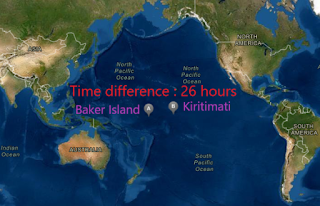 |
| maximum time difference |
Earth's largest time difference:
Time Zone may be used to refer to the local time of a country or a region. Time zones in the world are obtained from the UTC. If each time zone were 1 hour apart, there would be 24 time zones in the world. The clocks throughout the World are not adjusted for Daylight savings as all are under the regulation of a Coordinated Universal Time (UTC).
UTC is 0 hours which means any area on the Earth can only be ahead (+) or behind (-) the UTC. We know that there are 24 hours in a day, so we may think that the biggest time difference between two points on the earth would only be 24 hours. But, according to the standard time (UTC) which we follow, the biggest time difference is 26 hours. The reason behind this is because of the man-made imaginary International Date Line (IDL) which was agreed in 1884 at the International Meridian Conference (IMC). The IDL serves as the "line of demarcation" between two consecutive calendar dates.
If a person crosses the IDL from the West to the East he gains a day and if he crosses from the East to the West he loses a day. If the IDL is a straight line, then the maximum time difference would only be 24 hours, but the IDL agreed is not a straight line, it is a zig-zag line. The countries which attended the IMC decided the IDL to run North pole to South pole, but make it zig-zag around political borders to avoid any confusion. Also, if it was a straight line, then it demarcates the same landmass into two parts and then both places have different dates on the same day. This is the reason the IDL is not straight in many places.
The maximum time difference between two places on the Earth is 26 hours, which is between the Republic of Kiribati’s Kiritimati (UTC + 14) and Baker Islands (UTC - 12) of the United States of America (A minor outlying island).
Both the islands are located in the Pacific Ocean in which Kiritimati falls on the Western side of the IDL and Baker Island falls on the Eastern side of the IDL. Theoretically, speaking the Baker Islands should be on the East side of Kiritimati.
But practically, the situation is different. Kiritimati lies on the Eastward side of Baker Island, but on the West of the IDL. The image on the top will give you a clear idea about how the IDL is passing between these two places and the reason for the 26 hours time difference.
Other than Kiritimati and Baker Island, the largest time difference may be accepted between Howland Island ( Another minor outlying island) of America (UTC - 12) and the Independent State of Samoa, whose Daylight Saving Time (DST) during summer is UTC + 14. Samoa uses DST to make the darkness fall later each day according to the clock. But, this may not be considered throughout the year as the DST for Samoa starts at the end of September and ends at the beginning of April.



Very nice
ReplyDeleteNice read
ReplyDeleteInteresting read. Great job
ReplyDeleteWonderful article..very informative..
ReplyDelete